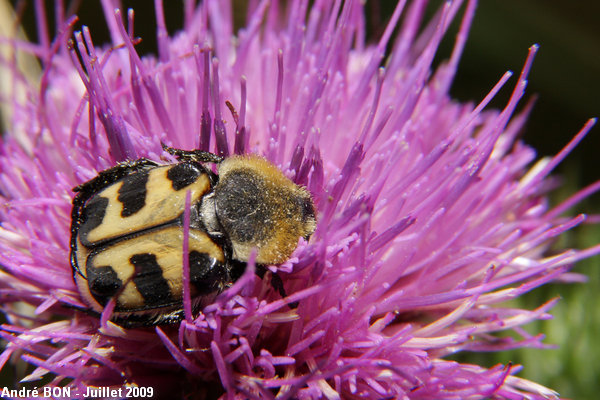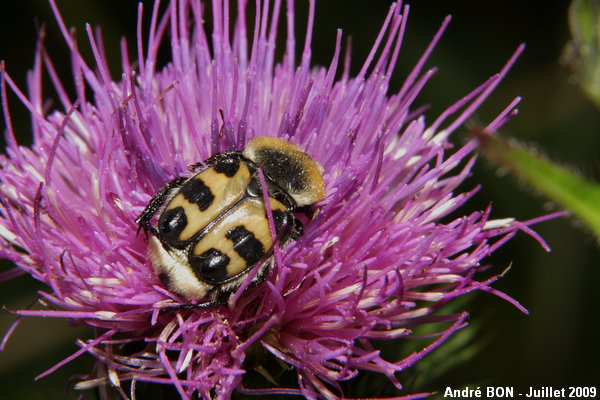



| Bee Beetle (Trichius zonatus (Germar, 1829)) |




|
|
Scientific name: Trichius zonatus (Germar, 1829) Common name: Bee Beetle Other names: Other scientific name: Trichius rosaceus. French name: Trichie zonée Order: Coleoptera Family: Cetoniidae Wingspan : 9 to 12 mm. Biotope: Deciduous forests. The larva grows during two years in Beech, Birch, Alder or other rotting wood. You can observe adults on flowers, especially umbelliferae flowers, in clearings, near woodland edges or in sunny flower meadows. Geographic area: Europe, North Africa. Observation period : June to August. |
Trichius zonatus shows a dense fur which is a golden colour on the upper side and yellowish or whitish on the lateral sides of the body. The thorax is a more or less dark brown colour. The elytra are yellow or orange and crossed by three black stripes which are interrupted in the middle. These marks are variable and you can find specimen with much larger black patches. The suture between the elytra is black. There are two similar species, Trichius fasciatus and Trichius sexualis. In France, Trichius sexualis is restricted to the Vosges and Alsace regions. Females show two deep notches at the rear of the last sternite. Males have an important white pubescence on the four sternites before the last one (a view of the under side is needed). In the other regions of France (and in northern Europe) you just need to tell Trichius zonatus and Trichius fasciatus apart. The most reliable criteria is based on a sharp tooth located at two third of the tibia on the middle legs of Trichius fasciatus. Trichius zonatus only shows a small rounded bump at the same location. I have read different information about the patterns on the elytra. It seems commonly admitted that, because of variation, the patterns must not be part of the keys but must only be considered as an indication. The black area close to the thorax usually form a continuous transverse black stripe on Trichius fasciatus while it is restricted to two lateral black patches on Trichius zonatus. I have read that if the yellow area touches the shoulders, then you can decide for Trichius zonatus. Based on experience and because of variability I think that you cannot trust this information and you must stay at Trichius sp. if you can't evaluate the presence of a tooth on the median tibia (in places where Trichius sexualis is missing of course). |
| [To know more about the Bee Beetle] [Next picture] [Top] |

|
I have observed this Bee Beetle in my garden on Pyracantha blossom. You can clearly see the middle leg's tibia and you cannot see any sharp tooth on it. However, having now some more experience, I think it would not be correct to conclude with a 100% probability for Trichius zonatus. Depending of the angle of view a sharp tooth can be seen as a small bump. Let's say Trichius zonatus probable but not sure. I am more and more thinking that you must not use the colour pattern of the elytra to tell species apart. |
| [To know more about the Bee Beetle] [Next picture] [Previous picture] [Top] |

|
I think that this Bee Beetle was sleeping on the flower. It is always very unpleasant to be waken up while taking a nap. So I have not disturbed this Be Beetle to see one tibia of its middle legs. I have first told it apart as Trichius zonatus because of the size of the yellow area touching the shoulder. I have changed my mind after having observed, in another region, Trichius fasciatus with exactly the same colour pattern on the elytra. I am even wondering if the rather dark yellow colour could rather indicate Trichius fasciatus more probable than Trichius zonatus. |
| [To know more about the Bee Beetle] [Next picture] [Previous picture] [Top] |

|
Because of its immobility, I have wondered if this insect was alive. A few movements of the legs have made me think that it was only asleep. |
| [To know more about the Bee Beetle] [Previous picture] [Top] |

|
I have done this observation among flowers next to a deciduous woodland edge. This is the typical habitat where you can find Bee Beetles. |